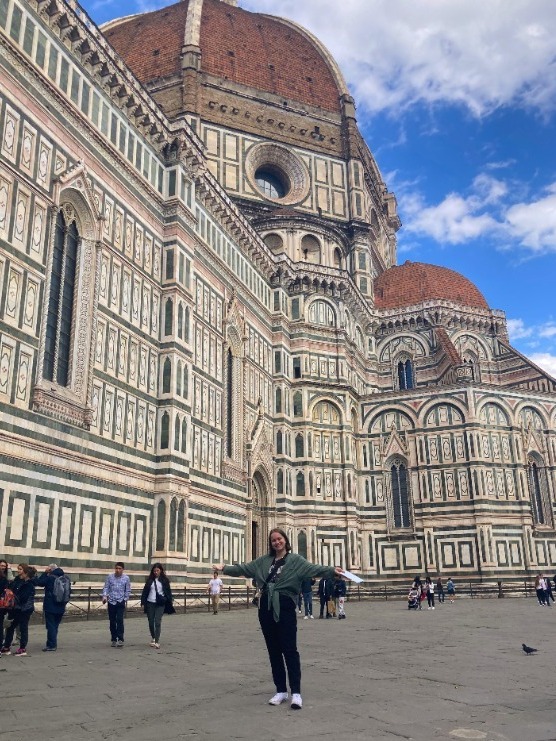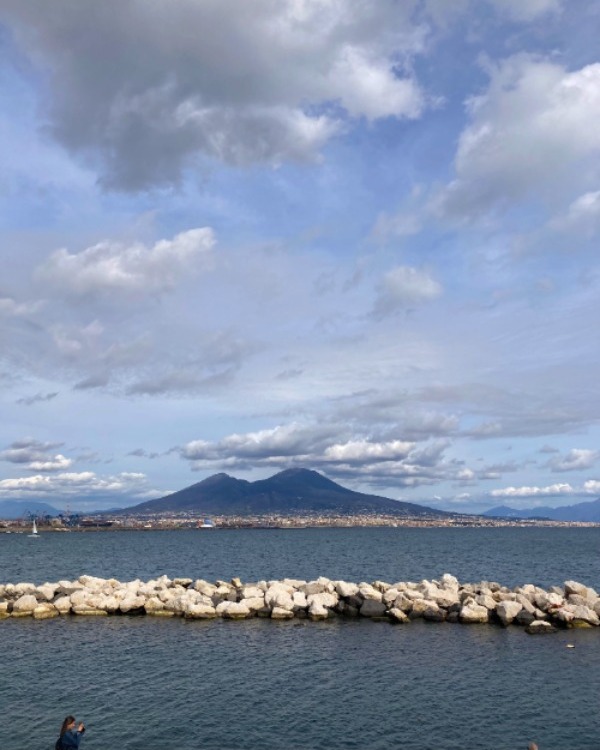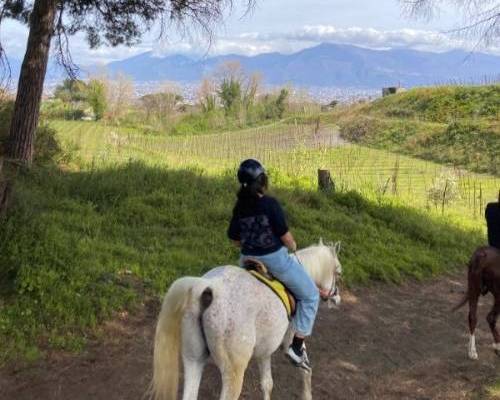Contact Us



Global Engagement Office
Cheney International Center
1000 E University Ave
Laramie, WY 82071
Phone: 1-307-766-3677
Email: global@uwyo.edu
Cowgirls in Italy
Published November 17, 2023
By Alea Denney
 What did the University of East Anglia in Norwich, England, and Lorenzo de' Medici International Institute in Florence, Italy have in common during the spring semester of 2023? They both had
University of Wyoming students studying abroad there! A very rare coincidence, given
that the current population of Wyoming is approximately 0.0072% of the world’s total
population. I was lucky enough to be a Poke in Britain, while my best friend Kynlee
was in Italy. Over spring break, I went to visit her and we embarked on an epic journey
from Florence all the way down the Amalfi coast.
What did the University of East Anglia in Norwich, England, and Lorenzo de' Medici International Institute in Florence, Italy have in common during the spring semester of 2023? They both had
University of Wyoming students studying abroad there! A very rare coincidence, given
that the current population of Wyoming is approximately 0.0072% of the world’s total
population. I was lucky enough to be a Poke in Britain, while my best friend Kynlee
was in Italy. Over spring break, I went to visit her and we embarked on an epic journey
from Florence all the way down the Amalfi coast.
Kynlee and I have lived in small towns our whole lives. Taking the plunge to go live in Europe for a semester was a scary jump, but we took it together to our respective exchange locations. As an International Studies student, I chose Britain for its relevance to my major’s regional concentration in Europe and the Former Soviet Union, as well as its cheap cost of travel around the continent, academically rigorous courses, unique political history following Brexit, and its role as our close ally and a P7/G5 country. Kynlee, an art education student, chose Italy for its rich and diverse artistic history, its bustling yet manageable location, beautiful landscapes, and world-class painting and sculpting influence. We knew immediately a legendary odyssey had to be in order for us, in true Wyoming Cowboy spirit, as we forged into our unknown.
Our spring break trip began in Florence, where Kynlee was my tour guide. We explored all the best tourist spots and hidden gems across the city. This included the Duomo, Boboli Gardens, the greatest sandwiches the world has ever seen, the Uffizi Gallery, and so much awesome pasta I almost keeled over. I was amazed to learn about the di Medici family’s impact on the city and to learn about the city’s relevance for the Renaissance. The way that time period treated artistic expression and philosophical ideas as valuable imports and exports fascinated me.
From Florence, we hopped on a train to the Eternal City, Rome. I immediately fell in love. There are many places around the world where it feels like the ancient and the modern coexist. Rome did not quite fit that ticket. Instead, it felt as if the modern had embraced the past and was wearing it proudly, with archaeological ruins in the center of the city, neighborhoods older than the United States, and cobbled streets that Marcus Aurelius and Julius Cesar had walked on. It was not an instance of old temples surrounded by glitteringly new skyscrapers. This was an empire gone by, whose bones had become gilded and carried into the present. We ventured on foot to all the major tourist spots, including running around the Vatican City during a hailstorm and gawking at the golden splendor of St. Peter’s Basilica.
Our big day of magic and history was the following day when we went to the Colosseum and the Roman Forum. Pictures do absolutely no justice for either of these sites. We saw graffiti that was thousands of years old, heard about the types of weapons used in the Colosseum, and were taught about the kinds of animals trafficked into Rome. The Roman Forum and Palatine Hill were my favorite by far, though, and I spent most of the time walking the grounds in a silent trance. The gravity of human potential hits you viciously hard at this location, seeing the still-standing remnants of these beautiful buildings and monuments, realizing the magnitude of impact and incredible artistic and destructive power humanity has. There is no choice but to be cowed by how far the human race has come when you are standing in the shadows of an empire.
 Our next stop was Naples and Pompeii. Gazing out across the Gulf of Naples and seeing Mount Vesuvius in the distance was
unforgettable. Even better was stepping foot into the ruins of Pompeii, a place I
had only ever read about in books or heard referenced in pop culture. This visit turned
out to be one of the most informative, fun, and captivating tours I’ve ever taken
in my life. Being the mature and serious college students we are, Kynlee and I delighted
in learning about Pompeii’s nightlife—I had not known it was a popular coastal vacation
destination for Romans, and our guide taught us all about exactly how the Romans partied.
We learned that ancient Romans had street food stands, built gutters in their streets
with elevated crosswalks so people wouldn’t fall in puddles, and performed elaborate
dramas and comedies in their theaters. We also explored the elaborate bathhouses,
and I was blown away by the technological advances that were used to create hot tubs
and saunas by funneling steam under the floor structures.
Our next stop was Naples and Pompeii. Gazing out across the Gulf of Naples and seeing Mount Vesuvius in the distance was
unforgettable. Even better was stepping foot into the ruins of Pompeii, a place I
had only ever read about in books or heard referenced in pop culture. This visit turned
out to be one of the most informative, fun, and captivating tours I’ve ever taken
in my life. Being the mature and serious college students we are, Kynlee and I delighted
in learning about Pompeii’s nightlife—I had not known it was a popular coastal vacation
destination for Romans, and our guide taught us all about exactly how the Romans partied.
We learned that ancient Romans had street food stands, built gutters in their streets
with elevated crosswalks so people wouldn’t fall in puddles, and performed elaborate
dramas and comedies in their theaters. We also explored the elaborate bathhouses,
and I was blown away by the technological advances that were used to create hot tubs
and saunas by funneling steam under the floor structures.
I am receiving a minor in anthropology, so it was eye-opening to discover how ancient cities aren’t as different as I thought to destinations of today. Learning that Pompeii was still an active excavation site (only 1/3 uncovered) was even more exciting, and I inquired a lot about the types of tactics used to expose and preserve the ruins. Kynlee loved seeing the beautiful murals and mosaics that had survived the eruption, dissecting the animal motifs contained within them, and admiring the architecture. It was a salient reminder of how invaluable multidisciplinary approaches are to research, since no one field has all the answers! The active blend of archaeology, art, anthropology, political science, biology, conservation studies, and more that were present within Pompeii was really inspiring.
Of course, in Cowgirl fashion, we also went horseback riding at the base of Mount Vesuvius! We had a total blast touring local Russo family vineyard and farm, chatting with them about life in Southern Italy, and learning all about growing processes for grapes and equestrian competitions they had entered. The unique volcanic soil surrounding Vesuvius imbues the ground with a mineral-dense quality that produces exceptional crops, and the Russos explained how this creates the historical (and delicious) grape variety Lacryma Christi, or Christ’s tears. Many cats were pet and many pounds of spaghetti were consumed at the family estate, where we were surrounded by lively stories and new friends. It was the perfect way to wrap up our spring break.

Contact Us



Global Engagement Office
Cheney International Center
1000 E University Ave
Laramie, WY 82071
Phone: 1-307-766-3677
Email: global@uwyo.edu



